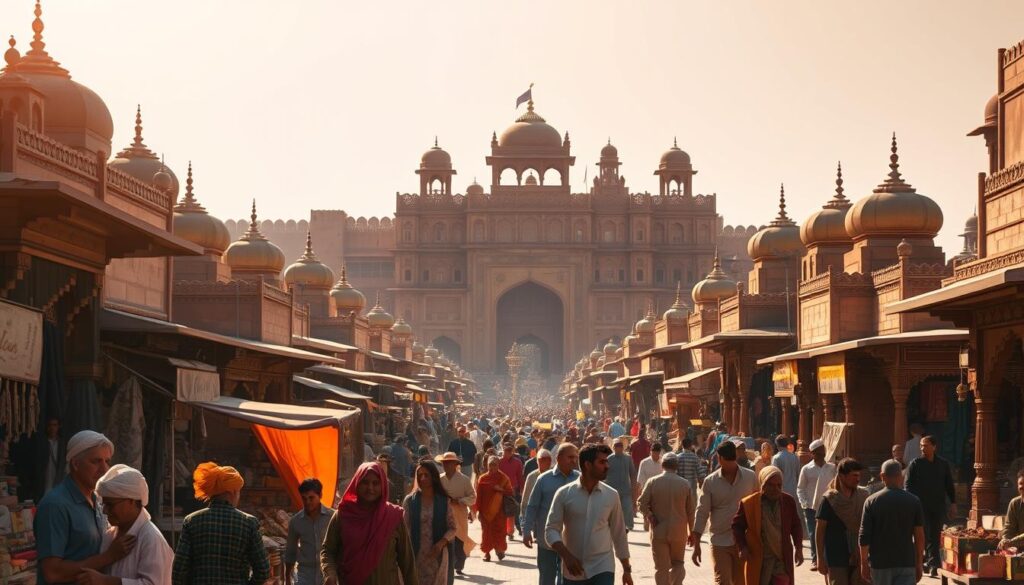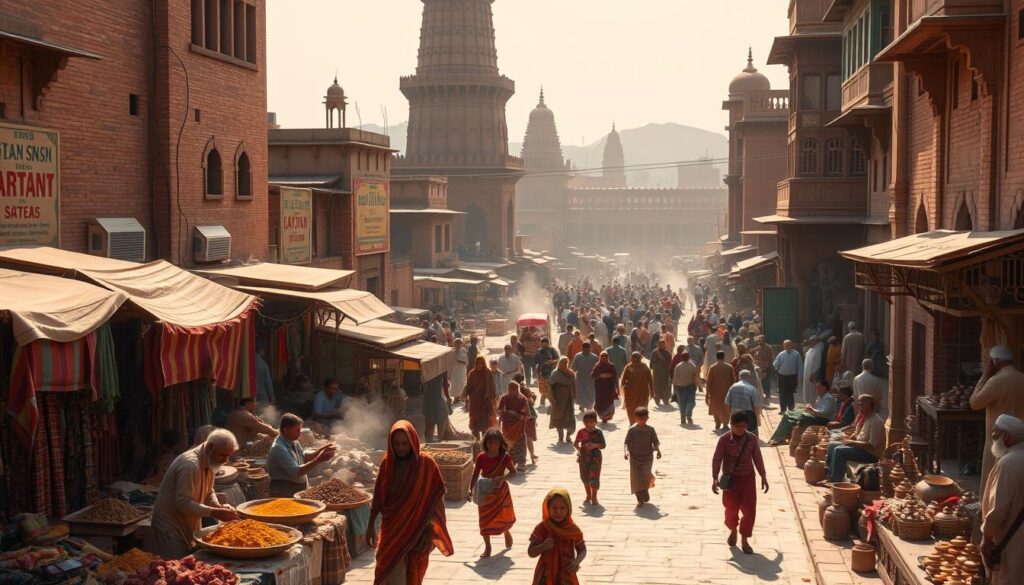What was daily life like in Fatehpur Sikri during Akbar’s reign: Step back in time and uncover the fascinating daily life in Fatehpur Sikri during Akbar’s reign.
Fatehpur Sikri was founded by Akbar in 1571. It was the capital of the Mughal Empire for about 14 years. This city in northern India was a center of culture and art, showing Akbar’s dream of a mixed and welcoming society.

Fatehpur Sikri was famous for its beautiful buildings, like the Buland Darwaza and the Jama Masjid. We will look at how the city’s design and cultural events shaped the lives of its people.
Key Takeaways
- Fatehpur Sikri was the capital of the Mughal Empire during Akbar’s reign.
- The city was known for its stunning architecture and cultural activities.
- Akbar’s vision for the city was centered around syncretism and inclusivity.
- The city’s brief existence had a lasting impact on Indian history.
- Fatehpur Sikri’s design reflected Akbar’s cultural and artistic ideals.
The Magnificent City of Fatehpur Sikri: Historical Context
Akbar’s dream of a society where everyone could live together was realized in Fatehpur Sikri. He built this city as his capital in the late 16th century. It shows the beauty of the Mughal era in architecture and culture.
The Founding and Layout of the Imperial Capital
Akbar started Fatehpur Sikri in 1569, near a sacred Sufi shrine. He planned the city carefully. It had areas for the palace, mosque, and market.

Architecture and Urban Planning Under Akbar
The buildings in Fatehpur Sikri mix different styles, showing Akbar’s dream of unity. The Buland Darwaza and Jama Masjid stand out with their red sandstone and white marble. Akbar’s city design was unique and practical.
The city’s design showed Akbar’s love for beauty and his wish for a welcoming society. During Akbar’s time, Fatehpur Sikri was full of life. It was a place of culture, religion, and trade.
What Was Daily Life Like in Fatehpur Sikri During Akbar’s Reign?
Daily life in Fatehpur Sikri during Akbar’s reign was rich and varied. The city was home to people from many backgrounds and cultures. This mix created a unique way of life.

Social Structure and Hierarchy
The social structure in Fatehpur Sikri was clear. The royal family and nobles were at the top. Below them were merchants, artisans, and laborers. This order was seen in the city’s buildings, with the palace and noble homes standing out.
Related Posts: What are the entry ticket prices for Fatehpur Sikri for Indian tourists?
Court Life vs. Common People’s Experience
Court life was full of grandeur and luxury. It featured big ceremonies and celebrations. But for common people, life was about daily work and struggles. Many were involved in crafts, trade, and other jobs.
Religious Practices and Cultural Diversity
Fatehpur Sikri was known for its religious tolerance. People of different faiths lived together, adding to the city’s culture. The city’s mosques, temples, and other buildings show this diversity, with different architectural styles.
Commerce, Crafts, and Economic Activities
The city’s economy thrived on crafts, trade, and commerce. Artisans and craftsmen made goods like textiles and metalwork. These items were sought after within the empire and beyond.
Food, Clothing, and Daily Routines
Daily life was also influenced by food, clothing, and cultural practices. The city’s food was a mix of traditions. Dishes like biryani were favorites among the people.
Conclusion
Exploring daily life in Fatehpur Sikri during Akbar’s reign reveals the richness of human experience. The city’s history and cultural significance are timeless. They give us a glimpse into the complexities of society and culture.
Daily life in Fatehpur Sikri was a blend of social hierarchy, religious diversity, and economic activities. This history shows why preserving cultural heritage is vital. It also emphasizes the importance of understanding different cultures.
The legacy of Fatehpur Sikri teaches us about the vast cultural diversity in human history. Reflecting on this historic city’s importance, we see the need to keep our cultural heritage alive for the future.
FAQ
What was the significance of Fatehpur Sikri during Akbar’s reign?
Fatehpur Sikri was the capital of the Mughal Empire under Akbar. It was known for its stunning architecture and diverse culture.
How did the city’s design reflect Akbar’s vision and values?
The city’s design showed Akbar’s dream of a united society. It combined different cultures and architectural styles, like red sandstone and white marble.
What was the social structure like in Fatehpur Sikri during Akbar’s reign?
The society was organized in a strict order. The royal family and nobles were at the top. Then came merchants, artisans, and laborers.
How did the city’s layout facilitate daily life?
The city was built to be practical and easy to navigate. It had areas for the palace, mosque, and market.
What was the role of commerce and crafts in Fatehpur Sikri’s economy?
Trade and crafts were key to Fatehpur Sikri’s economy. The city was a center of commerce and craftsmanship, showing the empire’s wealth.
How did Akbar’s policies influence the cultural diversity of Fatehpur Sikri?
Akbar’s rules encouraged mixing of cultures. This was seen in the city’s buildings, art, and everyday life.
What can we learn from the daily life in Fatehpur Sikri during Akbar’s reign?
Looking at daily life in Fatehpur Sikri teaches us about human experiences. It shows the value of keeping cultural heritage alive.

My name is Radha Sharma and I live in Agra. I have started this first blog of my life Agrafast.in to make my future in blogging by watching videos of many big bloggers through the internet for a long time.

